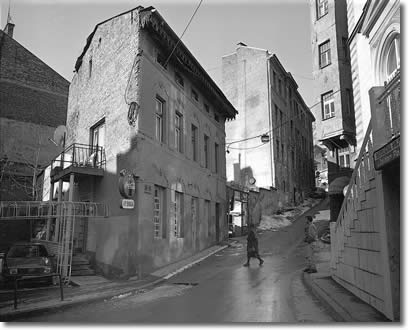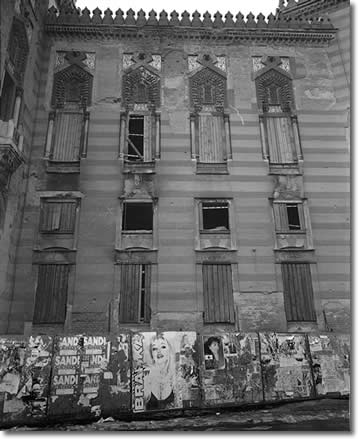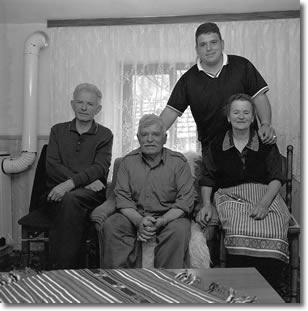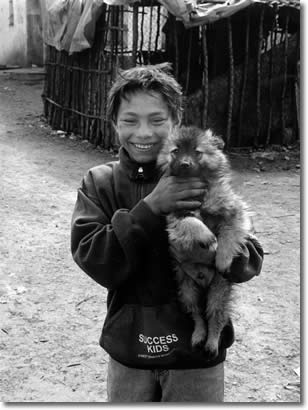The Unknown Europeans
One of the great fallacies of our time is the assumption that there is little left in Europe to be discovered. But there is still uncharted territory, regions which have remained terra incognita. Take, for example, the Aromanians, who has ever heard of them? Two Austrians, photographer Kurt Kaindl and author Karl-Markus Gauss, visited some of the smallest minorities of Europe, many of whom continue to struggle for their national survival today: the Sephardim in Bosnia-Herzegovina, the Albanian-speaking Arbereshe in Italy, the Slavonic Sorbs in Germany, the Romanic group of Aromanians in the Balkans, and the Degesi in Slovakia.
Gauss and Kaindl spoke with their political and cultural representatives and documented their culture with photographs that depict bizarre landscapes, neglected cemeteries, tidy little villages and people who know how to endure. The result of these encounters formed “The Unknown Europeans,” a book and exhibition, currently on view at the Austrian Embassy in Washington D.C.
Although these minorities never even aspired to creating their own nation state, they have been able to defend their cultures over many centuries of historical vicissitudes. They are living evidence for a vision of Europe where the dismantling of national boundaries is not a loss of identity but allows ethnic diversity to thrive. Paradoxically it is these people whom nobody knows, that are not only witnesses of an older, forgotten Europe but pioneers of a future Europe. They will contribute to the new ethnic, religious, linguistic and cultural diversity of tomorrow. The following is an excerpt of a longer text by Karl-Markus Gauss.
The Sephardim
In 1492, Isabelle and Ferdinand of Spain issued the “sanctimonious” decree to expel the Jews who had lived there for centuries from the peninsula. Many of them made their homes elsewhere. Sarajevo soon became one of their most important centers, which they came to call “Yerusalajim chico” or little Jerusalem. During WW II, the Bosnian Jews were first disenfranchised and plundered by the German-Croatian forces and then deported to concentration camps.

At the edge of the Old City, Sarajevo
The dream of many Sephardim to return to the mythical homeland of Spain was never realized. Around one thousand of the Sephardim are thought to have survived persecution during the War. When Yugoslavia disintegrated so violently in the 1990s and Sarajevo was besieged, many Jews determined to emigrate once more. As they saw it, nationalism had triumphed again, and the Jews who had proven themselves as such reliable couriers and go-betweens in the past, had no place in the middle of the Serbian-Croatian-Bosnian conflict.

The National Library, Sarajevo, Bosnia 1999
Around 400 people left the city in a large convoy and moved on to settle in Israel, Canada, and the USA. The Jewish community that remained behind is comprised of anywhere from 70 to 700 people. Most of them are old, and they all live with the knowledge that they are the last of their kind. They are the final relics of Sarajevo’s 500 year-long Sephardic culture, which irretrievably ends with them.
The Arbereshe
With the demise of the Albanian national hero, Gjergj Kastrioti Skënderbeu (1405-1468), also known as Skanderbeg, the Sultan’s army of the Ottoman Empire moved greatly unchallenged throughout the area. The defeat was unbearable for many Albanian Arbereshe, and in the face of their hopelessness, thousands undertook the perilous journey across the sea to Italy.

The sacristan of the former cloister, Colegio San Demetrio Corone, Italy
When the Albanians reached Naples, the Italian people welcomed them with open arms. Over the course of the next 200 years, seven major waves of emigration by various Albanian peoples arrived at the boot-shaped peninsula, altogether half a million people. Although the Albanians who stayed in Albania eventually came to call themselves ‘Shqiptare,’ those living in Italy continue to identify themselves as Arbereshe. The Arbereshe took up residence in the poorer southern regions of Italy where they live today.
Most of their settlements are in Calabria, where the language that died out long ago among the Albanians in Albania can still be heard in any bar in the approximately thirty communities. Today there are around 100,000 Italians who identify themselves as Arbereshe, who remain proud of their language, maintain many Albanian traditions and have Catholic priests to whom the Vatican recently awarded the right to marry and conduct mass according to the Greek Catholic traditions. It was not until 1999 that the first law was introduced recognizing the existence of the Albanian minority in Italy.
The Sorbs
Lusatia is a landscape of enchanting beauty. It is some 62 miles long, half so wide, and is fed by the river Spree that flows the length of the area from south to north. In this region of Germany, bordering Poland to the east and the Czech Republic to the south, the Sorbs live in small cities or in picturesque hamlets, many of which have been seized, destroyed or levelled over the course of the last century.
The Sorbs’ historical origins date back to the year 805 A.D. For 1,200 years, they suffered under a series of changing rulers and were repeatedly forbidden to use their native Sorbian language. Sorbian is not a dialect but rather a distinct West Slavic language with a rich vocabulary and its own grammar.
The ‘Wends,’ another name for the Sorbs, tenaciously withstood all hardships and resisted the temptation to assimilate. They have lived among the Germans since the very beginning. Under National Socialist rule, the strong, consistent pressure exerted on them to become “Germanized” heightened to the level of brutal persecution. After 1945, some Sorbs lobbied to bring Lusatia under Czech rule, and had they been successful, there would probably not be any Sorbs remaining today.
Sorbian is so similar to the Czech language that a swift assimilation of the kind that the Sorbs had resisted for centuries vis-à-vis the Germans could easily have come to pass. Today, there are still some 60,000 Lusatians who belong to the Sorbian community; and they have the right to their own schools and various forms of government assistance. It seems, however, that because outside pressures have now lessened, the ethnic group has begun to slowly crumble from within.
The Aromanians
The Aromanians are a nation without a state and have played a significant role in the history of the Balkans. Since they are almost nowhere recognized as a minority group, their identity is particular associated either with a particular country or sometimes a targeted upper class.
Apart from being scattered throughout the continent, today a large number of them live in Greece, Macedonia, Albania and Romania and in smaller numbers in Serbia and Bulgaria. There have been Aromanians who were Greek ministers, Serbian academy members, Bulgarian national prize winners, Romanian soccer stars and Austrian conductors.

Farmer's family from Nizepole
The origins of the Romanic Aromanians become lost amidst the murkiness of legends and myths. Throughout their history, the Aromanians have never lived separately but always were deeply enmeshed with other nationalities, and as far as one is aware of, never aspired to creating a nation state. What they wanted and needed, were open borders so that they could maintain unrestricted contact with their relatives, clan members, and friends within society.
Under Ottoman rule, their rights to remain an independent nationality were respected. When the Ottoman Empire collapsed, the governments of the Christian nations succeeding them immediately denied them this status. In Albania, the Aromanians are today the second largest population group, although they are overlooked by the census, because they are considered Greeks in disguise.
Also in Greece, which is a member of the European Union, their rights to protection as a minority group, have been persistently refused. The situation is better in Macedonia where they have recently established strong political and cultural organizations, and some of them have achieved considerable wealth in business such as the import-export trade.
The Degesi
The Romany or Roma group represents the largest minority within the European Union. Their living conditions are the furthest from European standards. In certain countries, such as Germany, Austria, or France, they have been able to improve their situation considerably. Elsewhere, particularly throughout the former Communist Bloc countries, their circumstances have become worse than ever before.
Yet the Roma, originally from India and often referred to derogatively as “Gypsies,” were perhaps the first true Europeans. This fact deserves particular emphasis today, since they often remain subject to reprisals, general ostracism, and a multitude of prejudices in many countries.

Roma district, Svinia 2003
The Roma are the first Europeans mainly because from the beginning they never aspired to create a nation state but conducted their lives according to the customs of the clans, irrespective of national borders. For centuries, the Roma have repeatedly suffered from pogroms, in spite of the fact that they have contributed in significant ways to the economies of their “host” countries as harvest laborers and specialists in certain trades.
Some 400,000 to 500,000 Romany live in Slovakia today. In several places, many of the Roma communities are proceeding toward a phase of self-destruction from within. The caste society has persisted, in which today almost all are among the lower classes. The ‘Degesi,’ Hungarian for “dog eaters,” live mainly in isolated slums and in many places have lost all remnants of their living culture and family histories. The only chance of success for well-intentioned relief projects, initiated by concerned Slovakians and in some places financed by the European Union, comes if the projects are developed and implemented not only for the Roma, but in cooperation with them as well.
Kurt Kaindl
Born in 1954 in Gmunden, Austria, he trained as a photographer while completing a Ph.D degree in Salzburg. He was one of the founding members of the Galerie Fotohof in 1981 and since 1975 has held numerous photo exhibitions of his work. A teacher at several universities, he resides in Salzburg where he is primarily a photographer and freelance journalist, as well as the editor of the Edition Fotohof from Otto Müller Publishers, Salzburg. Kurt Kaindl: Die Unbekannten Europäer (The Unknown Europeans) with texts by Karl-Markus Gauss (available in German only, English translation for exhibition by Anna Glass); Salzburg 2002; ISBN 3-7013-1060-2. E-mail: office@b-k.co.at
Karl-Markus Gauss
Born in 1954 in Salzburg, where he lives and works as the author of numerous books, Gauss is editor of the periodical, “Literatur und Kritik.” In 2001, he published a book on his visits to the unknown peoples of Europe under the title, “Die Sterbenden Europäer” Zsolnay Publishers. In January 2006, Gauss was awarded the Manès Sperber Prize by the Republic of Austria for his outstanding literary work in the area of socio-political topics.
All Photos on this page by Kurt Kaindl.
For more on the collaborative efforts of Kurt Kaindl and Karl-Markus Gauss, refer to the May/June 2004 issue of Austrian Information.
